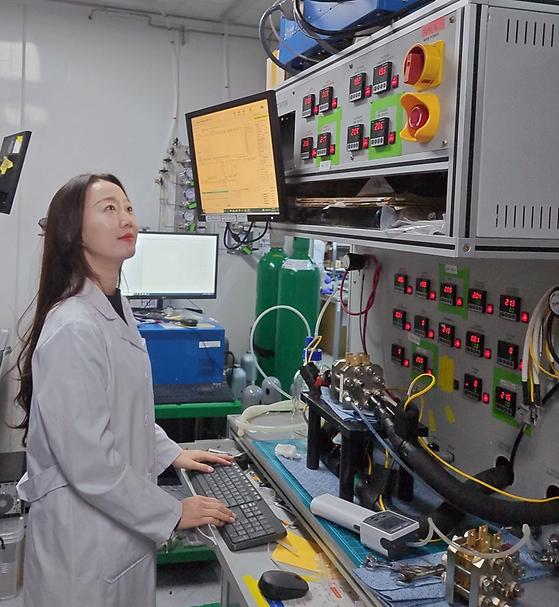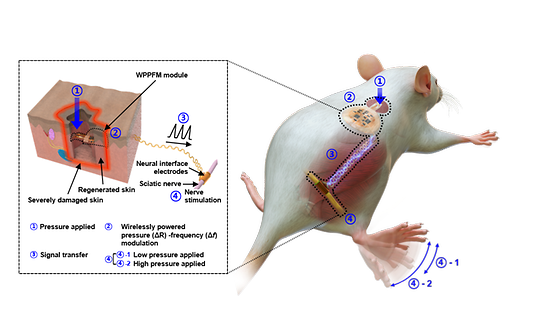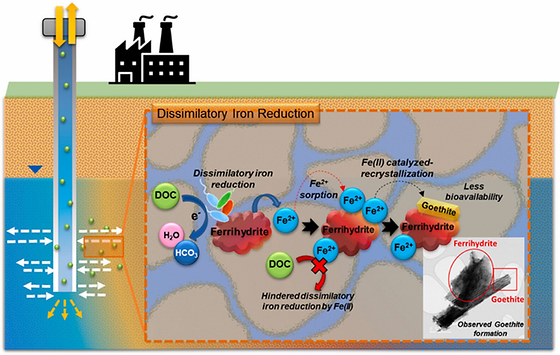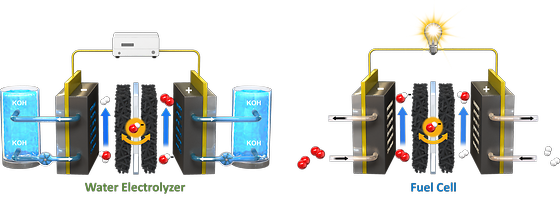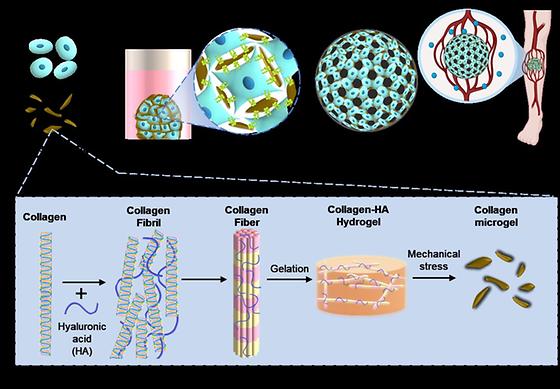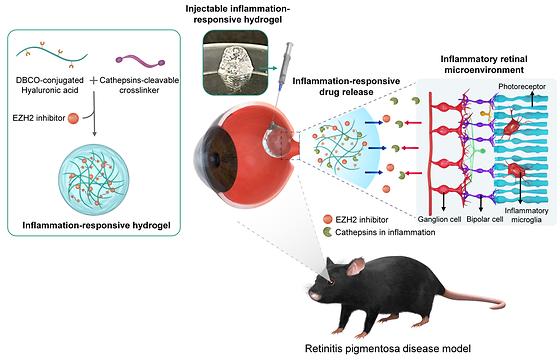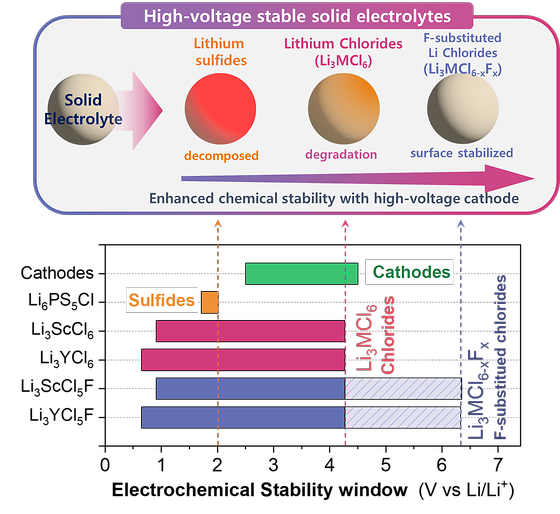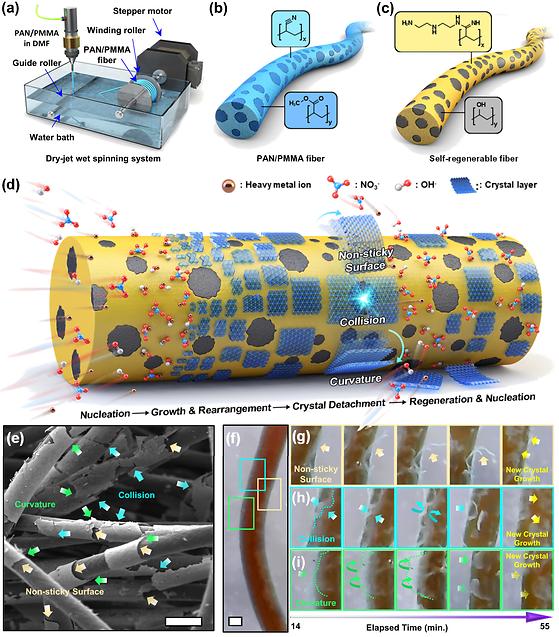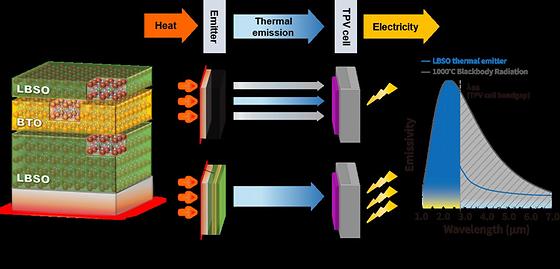Latest Research News
-
97
Development of Durability Evaluation Technique Against Solar Variability for Advancing Green Hydrogen Production
- Development of Durability Evaluation Technique Reflecting Solar Output Variability for Green Hydrogen Production Devices - Guidelines for Developing Core Components for Green Hydrogen Production via Water Electrolysis As green hydrogen gains attention as a future clean energy carrier, the question of which renewable energy to utilize as an energy source becomes increasingly important. Among them, solar energy has the advantage of being available everywhere on Earth, with low dependence on natural topography. However, fluctuations in solar output and generation due to factors such as season and weather lead to repetitive increases and decreases in power, posing a challenge of damaging components of production devices. Therefore, precise evaluation of the durability of devices under power fluctuations is crucial for determining the optimal timing for component replacement and developing new materials. Dr. Bora Seo's research team from the Hydrogen and Fuel Cell Research Center at the Korea Institute of Science and Technology (KIST), led by Director Yoon Seok-jin, has developed a durability evaluation technique for green hydrogen production devices with step durations as short as one second, utilizing actual solar irradiance data. This represents the application of the shortest step duration among developed techniques, enabling the most accurate simulation of fluctuations in actual solar energy output. To increase the applicability of solar energy to green hydrogen production devices, a reliable durability evaluation technique is required. However, existing durability evaluation methods have not accurately reflected solar output variability, relying solely on simple methods such as periodic cycling or constant maintenance of current and voltage. Additionally, there have been no standardized evaluation criteria for assessing the durability of core materials for water electrolysis under power fluctuation conditions. The research team has developed a simulation method that converts irradiance values into current densities using actual solar irradiance data obtained from solar panels, and using water electrolysis stack data. This has dramatically shortened the step duration from 10 seconds to 1 second, allowing fluctuations in solar output to be accurately reflected. Moreover, based on the newly developed durability evaluation technique, the team has proposed key indicators for the material development of green hydrogen production devices. Standardized analysis methods for assessing performance degradation of materials such as catalysts and electrolyte membranes, as well as indicators of performance degradation such as catalyst leaching amount, fluoride release rate, and thickness of passivation layer have been newly proposed. These guidelines can be utilized for the development of materials and components to improve the durability and performance of green hydrogen production devices. The developed durability evaluation technique can diagnose the precise condition and predict the remaining lifespan of solar-based green hydrogen production devices, facilitating efficient equipment investment and enhancing competitiveness in materials and components. This technology is expected to be applicable to assessing the performance of green hydrogen production devices based on other renewable energies such as offshore wind and tidal power. Dr. Seo stated, "This research achievement marks the first attempt to evaluate the durability of green hydrogen production devices by reflecting solar output variability most closely to reality," adding, "This can contribute to efficient equipment investment and enhancement of competitiveness in materials and components for green hydrogen production systems." [Figure 1] Comparison of Solar-Based Durability Evaluation Techniques with Constant Current and Cyclic Current Methods [Figure 2] Degradation Analysis of Key Materials for Water Electrolysis Before and After Solar-Based Durability Evaluation [Figure 3] Durability Evaluation Experiment Reflecting Solar Output Variability for Green Hydrogen Production Devices ### KIST was established in 1966 as the first government-funded research institute in Korea. KIST now strives to solve national and social challenges and secure growth engines through leading and innovative research. For more information, please visit KIST’s website at https://eng.kist.re.kr/ This research was supported by the Ministry of Science and ICT (Minister Lee Jong-ho) through KIST's major projects and the Ministry of Trade, Industry and Energy (Minister Ahn Dae-keun) through the Materials and Components Technology Development Project (20022451). The research results have been published in the prestigious international journal "Energy & Environmental Science" (IF 32.5, JCR top 0.4%) in the field of environmental energy.
- 96
- WriterDr. Seo, Bora
- 작성일2024.04.08
- Views818
-
95
Developing artificial skin that can regenerate skin and transmit sensation at the same time
- Development of biomimetic bionic skin and tactile neurotransmission system - Successful animal model implantation of bionic artificial skin composed of sensors and biomaterials Damage to nerve tissue due to skin defects such as burns, skin diseases, and trauma causes loss of sensory and cognitive functions that are essential for life-sustaining activities, as well as mental and physical distress. If the damage is severe enough that natural healing is not possible, surgical treatment is required to implant artificial skin in the affected area, but the artificial skin developed to date has focused on skin regeneration, providing a structure and environment similar to skin tissue, but has not restored sensation to patients. The Korea Institute of Science and Technology (KIST) announced that a research team led by Dr. Youngmee Jung of the Center for Biomaterials and Dr. Hyunjung Yi of the Post-Silicon Semiconductor Institute, in collaboration with Prof. Ki Jun Yu of Yonsei University and Prof. Tae-il Kim of Sungkyunkwan University, has developed a human-implantable tactile smart bionic artificial skin. Unlike conventional artificial skin, which focuses on skin regeneration, smart bionic artificial skin can restore even permanently damaged tactile senses by fusing biocompatible materials and a tactile function delivery system implemented with electronic devices. The artificial skin developed by the team is a hydrogel composed of collagen and fibrin, the main components of skin, that can detect even small pressure changes by inserting crack-based tactile sensors. The sensed pressure changes are converted into electrical signals via Wireless powered pressure-frequency modulation (WPPFM) circuit, which are then transmitted to the nerves by tactile nerve interfacing electrodes, allowing the device to perform the same tactile functions as the skin. The researchers also found that collagen and fibrin, which are responsible for skin's elasticity and tissue connectivity, trigger the proliferation and differentiation of skin cells around the wound to promote skin regeneration. The smart bionic artificial skin was implanted into rats with severe skin damage to test its effectiveness in promoting skin regeneration and reestablishing tactile function, and it showed a wound healing effect of more than 120% compared to the control group at 14 days after implantation. In addition, it detected external changes in the pressure range of 10 to 40 kPa, which is similar to the pressure range felt by human fingertips, and adjusted the electrical signals accordingly to change the rat's response. In particular, the artificial skin developed by the researchers is effective for sensory transmission and skin regeneration because it is implanted directly into the nerves along the subcutaneous fat layer of the damaged skin. After skin regeneration in patients with nerve damage, tactile sensors can operate in the subcutaneous layer, greatly improving independence in daily life. Even in the case of elderly people with degenerated sensory functions, it is expected that the degenerated sensory functions can be restored by directly inserting tactile electronic devices made with high-density integration technology into the subcutaneous layer. "This research is the result of convergence research on devices, materials, and regenerative medicine that effectively combines biomaterials and electronic device technology," said Dr. Youngmee Jung of KIST. "We plan to conduct additional clinical trials in collaboration with medical institutions and companies for commercialization, and we also plan to expand our research to reconstruct various functions of skin tissue such as temperature, vibration, and pain." [Fig 1] Human Implantable Tactile Function Smart Bionic Artificial Skin Components [Fig 2] Neural transmission mechanisms of external stimuli through integrated devices ### KIST was established in 1966 as the first government-funded research institute in Korea. KIST now strives to solve national and social challenges and secure growth engines through leading and innovative research. For more information, please visit KIST’s website at https://eng.kist.re.kr/ This research was supported by the Ministry of Science and ICT (Minister Lee Jong-ho) through the Nano-Materials Source Technology Development Project (2018M3A7B4071106). The findings were published in the latest issue of Nature Communications (IF 16.6, top 7.5% in JCR), a sister journal of Nature and a global authority on international interdisciplinary research.
- 94
- WriterDr. Jung Youngmee
- 작성일2024.04.04
- Views953
-
93
Twist of groundwater contaminants
- Synergistic effect of nitrate on natural purification of groundwater discovered - New water quality management paradigm for Aquifer Storage Recovery (ASR) techniques to secure stable water resources In recent years, the world has been experiencing floods and droughts as extreme rainfall events have become more frequent due to climate change. For this reason, securing stable water resources throughout the year has become a national responsibility called 'water security', and 'Aquifer Storage Recovery (ASR)', which stores water in the form of groundwater in the ground when water resources are available and withdraws it when needed, is attracting attention as an effective water resource management technique. The Korea Institute of Science and Technology (KIST) announced that a team of Dr. Seunghak Lee, Jaeshik Chung, and Sang Hyun Kim from the Water Resources Cycle Research Center has discovered that the natural purification of groundwater is enhanced by nitrate, a known pollutant. In order to apply ASR techniques in practice, it is very important to predict and manage the quality of recharged water, and this research is expected to mark a turning point in the water quality management strategy of ASR systems. In addition to storing water resources, ASR techniques have the added benefit of improving water quality through various reactions in the ground. The organic pollutants in the recharged water are degraded by the interaction of microorganisms in the aquifer soil with the iron oxide minerals, and in general, the iron oxide minerals are gradually transformed and the effective surface area is reduced, causing the natural attenuation of organic pollutants to stop. The KIST researchers found that the coexistence of nitrate in the recharged water leads to the formation of a new type of iron oxide, which results in a much higher removal efficiency than the stoichiometrically predicted organic pollutant removal efficiency. The coexistence of nitrate increases the duration of natural attenuation because it creates new species of iron oxides that can sustain the degradation of organic contaminants. Furthermore, the researchers found that the pollutant nitrate is removed during the overall reaction. "This is the first study to confirm the positive role of nitrate in groundwater, which is known only as a water pollutant," said Dr. Seunghak Lee of KIST. "Based on this, we are promoting the development of ASR water quality management protocols that dramatically change the existing water quality management paradigm, such as introducing allowable standards for nitrate residue in the pretreatment process of the recharging water." [Fig 1] Aquifer Storage Recovery (ASR) Overview [Fig 2] Natural attenuation of organic pollutants by iron oxide reductive dissolution in aquifers during ASR [Fig 3] Increased removal efficiency of organic pollutants due to the generation of new type of iron oxide minerals in the presence of nitrate ### KIST was established in 1966 as the first government-funded research institute in Korea. KIST now strives to solve national and social challenges and secure growth engines through leading and innovative research. For more information, please visit KIST’s website at https://eng.kist.re.kr/ The results of the research, which was funded by the Ministry of Science and ICT (Minister Jong-ho Lee) through the Climate Change Impact Minimization Technology Development Project (2020M3H5A1080712) and the KIST K-Lab Program (2E33084), were published in the February issue of the international journal Water Research. Journal : Water Research Title : Synergetic effect of nitrate on dissolved organic carbon attenuation through dissimilatory iron reduction during aquifer storage and recovery Publication Date : 2024.02.01. DOI : https://doi.org/10.1016/j.watres.2023.120954
- 92
- WriterDr. Lee, Seunghak
- 작성일2024.03.27
- Views1037
-
91
Developing bifunctional catalyst performance enhancement technology that will lower the cost of hydrogen production
- Overcoming the durability limits of bifunctional catalysts for simultaneous hydrogen and oxygen production - Presenting large area reactor drive technology for commercialization of electrochemical systems Dr. Hyung-Suk Oh and Dr. Woong-Hee Lee of the Clean Energy Research Center at the Korea Institute of Science and Technology (KIST), in collaboration with POSTECH and Yonsei University, have developed a methodology to improve the reversibility and durability of electrodes using bifunctional platinum-nickel alloy catalysts with an octahedral structure that exhibits both oxygen reduction and generation reactions. Bifunctional catalysts are a new generation of catalysts that simultaneously produce hydrogen and oxygen from water using a single catalyst. Currently, electrochemical systems such as water electrolysis technology and CCU (carbon dioxide capture and utilization) utilize separate catalysts for both electrodes, resulting in a high unit cost of hydrogen production. On the other hand, bifunctional catalysts that can be synthesized in a single production process are attracting attention as a technology that can reduce production costs and increase the economic efficiency of electrochemical energy conversion technologies. However, the problem with bifunctional catalysts is that after each electrochemical reaction that generates hydrogen and oxygen, the performance of other reactions decreases due to structural changes in the electrode material. Therefore, in order to commercialize bifunctional catalysts, it is important to secure reversibility and durability that can maintain the catalyst structure for a long time after the reaction. To enhance the reversibility and durability of the bifunctional catalyst, the team synthesized alloy catalysts with different structures by mixing platinum and nickel, which have high performance in oxygen reduction and generation reactions, respectively. The experimental results showed that the nickel-platinum interaction was most active in the octahedral structure, and the alloy catalysts performed more than twice as well as the platinum and nickel monoliths in oxygen reduction and generation reactions. The researchers identified platinum oxide generated during the repeated generation reaction of the alloy catalyst as the cause of the performance degradation and developed a structure restoration methodology to reduce platinum oxide to platinum. The team confirmed through transmission electron microscopy that the methodology restored the catalyst's shape, and in large-area reactor experiments for commercialization, the team succeeded in restoring the catalyst shape and more than doubled the run time. The team's bifunctional catalysts and structure recovery methodology are expected to accelerate the commercialization of unitized renewable fuel cells (URFCs) technology by replacing the separate catalysts for oxygen evolution and reduction reactions with bifunctional catalysts. URFCs that can produce both hydrogen and electricity can lower production costs by reducing the input of expensive catalysts while maintaining performance. "The technology to improve the reversibility and durability of catalysts has provided a new direction for the development of bifunctional catalysts, which is an important technology for electrochemical energy conversion systems," said Hyung-suk Oh, lead researcher at KIST. "It will contribute to the commercialization and carbon neutrality of electrochemical systems such as URFCs in the future.“ [Fig 1] Unitized Renewable Fuel Cells operation schematic [Fig 2] Structural changes of platinum at each reaction step using X-ray photoelectron spectroscopy and in-situ X-ray absorption spectroscopy [Fig 3] In-situ X-ray absorption spectroscopy instrumentation schematic ### KIST was established in 1966 as the first government-funded research institute in Korea. KIST now strives to solve national and social challenges and secure growth engines through leading and innovative research. For more information, please visit KIST’s website at https://eng.kist.re.kr/ This research was supported by the Ministry of Science and ICT (Minister Lee Jong-ho) under the 'KIST Institutional Program', 'Carbon to X Project' (2020M3H7A109822921), and 'Creative Convergence Research Project' (CAP21013-100) of the National Research Council of Korea (Chairman Kim Bok-cheol). The results were published in the latest issue of the prestigious international journal 'Advanced Energy Materials' (IF: 27.8, top 2.5% in JCR) and were selected for the back cover image. Journal : Advanced Energy Materials Title : Activity restoration of Pt-Ni octahedron via phase recovery for anion exchange membrane-unitized regenerative fuel cells Publication Date : 2024.01.12. DOI : https://doi.org/10.1002/aenm.202302971
- 90
- WriterDr. Hyung-Suk Oh
- 작성일2024.03.21
- Views1099
-
89
Developing a stem cell therapy to prevent amputations from critical limb ischemia
Critical limb ischemia is a condition in which the main blood vessels supplying blood to the legs are blocked, causing blood flow to gradually decrease as atherosclerosis progresses in the peripheral arteries. It is a severe form of peripheral artery disease that causes progressive closure of arteries in the lower extremity, leading to the necrosis of the leg tissue and eventual amputation. Current treatments include angioplasty procedures such as stent implantation and anti-thrombotic drugs, but there is a risk of blood vessel damage and recurrence of blood clots, which is why there is a strong interest in developing a treatment using stem cells. A research team led by Dr. Sangheon Kim of the Center for Biomaterials Research at the Korea Institute of Science and Technology (KIST) announced that they have developed a three-dimensional stem cell therapy to treat critical limb ischemia through a self-assembling platform technology using a new material microgel. By using collagen microgels, a new biocompatible material, the researchers were able to easily transplant stem cells into the body and increase cell survival rate compared to 3D stem cell therapies made of cells alone. Stem cell therapies have high tissue regeneration capabilities, but when stem cells are transplanted alone, hypoxia at the site of injury, immune responses, and other factors can reduce cell viability and prevent the desired therapeutic effect. Therefore, it is necessary to develop a material that delivers stem cells using biodegradable polymers or components of extracellular matrix as a support to increase cell viability. The team processed collagen hydrogels to micro-scale to create porous, three-dimensional scaffolds that are easy to inject in the body and have a uniform cell distribution. Collagen, a component of the extracellular matrix, has excellent biocompatibility and cellular activity, which can induce cell self-assembly by promoting interactions between the microgel particles and collagen receptors on stem cells. In addition, the spacing between microgel particles increased the porosity of the three-dimensional constructs, improving delivery efficiency and cell survival. The microgel-cell constructs developed by the researchers expressed more pro-angiogenic factors and exhibited higher angiogenic potential than cell-only constructs. When microgel-cell constructs were injected into the muscle tissue of mice with critical limb ischemia, blood perfusion rate increased by about 40% and limb salvage ratio increased by 60% compared to the cell-only constructs, confirming their effectiveness in increasing blood flow and preventing necrosis in the ischemic limb. The new stem cell therapy is expected to provide a new alternative for patients with critical limb ischemia who have limited treatment options other than amputation due to its excellent angiogenic effect. Furthermore, since angiogenesis is an essential component of various tissue regeneration processes, it can be extended to other diseases with similar mechanisms to peripheral arterial disease. "The collagen microgel developed in this study is a new biomaterial with excellent biocompatibility and high potential for clinical applications," said Dr. Sangheon Kim of KIST. "We plan to develop technologies for administration methods required in the medical field, as well as conduct follow-up research to clarify the clear mechanism of action of the treatment and discover target factors." [Figure1] Collagen Microgels - The Concept of Self-Assembling Stem Cell Therapy [Figure2] Enhanced cell viability of microgel-assembled stem cell therapeutics [Figure3] Efficacy validation of microgel-cell constructs ### KIST was established in 1966 as the first government-funded research institute in Korea. KIST now strives to solve national and social challenges and secure growth engines through leading and innovative research. For more information, please visit KIST’s website at https://eng.kist.re.kr/ This research was supported by Korean Fund for Regenerative Medicine (22C0620L1). The findings were published in the latest issue of the international journal Bioactive Materials (IF 18.9, JCR top 1.1%). Journal : Bioactive Materials Title : A micro-fragmented collagen gel as a cell-assembling platform for critical limb ischemia repair Publication Date : 2023.12.16. DOI : https://doi.org/10.1016/j.bioactmat.2023.12.008
- 88
- WriterDr. Sangheon Kim
- 작성일2024.03.13
- Views1356
-
87
New treatment developed to dramatically slow down the progression of blindness-causing retinal diseases:
- Interactive release of anti-inflammatory drugs depending on the level of retinal degeneration. - A customized treatment approach is expected to be developed to reduce patients’ inconvenience of having multiple shots. The Korea Institute of Science and Technology (KIST) announced that Dr. Maesoon Im of the Brain Science Institute, together with Prof. Seung Ja Oh of Kyung Hee University and Prof. Kangwon Lee of Seoul National University, successfully incorporated anti-inflammatory drugs into a hydrogel to suppress inflammation in the retina and effectively deliver the drugs to the inflamed area. Age-related macular degeneration and retinitis pigmentosa are incurable eye diseases that cause blindness due to the gradual damage of photoreceptor cells, which convert light into biological signals in the retina, the light-sensitive tissue at the back of the eye. Age-related macular degeneration is a condition that damages the macula, the central part of the retina, and is the number one cause of blindness in people over the age of 65. Retinitis pigmentosa, on the other hand, is a genetic disorder that causes gradual death in the photoreceptor cells in the retina and affects about 1 in 4,000 people worldwide, initially causing night blindness but eventually leading to vision loss. Currently, there is no effective cure for either disease, and one of the treatments is to inject anti-inflammatory drugs into the eye to slow down the degree of retinal damage. However, these injections only work for as long as the drug remains in the eye, requiring patients to visit a clinic for intraocular injections every four to 12 weeks, depending on how long the effect of the drug lasts. For the first time, the team utilized a substance that inhibits the inflammatory factor EZH2, which contributes to retinal degeneration, along with an anti-inflammatory agent. When mice with retinal degeneration were injected with the anti-inflammatory drug, the progression of retinal degeneration slowed down. The researchers have successfully developed a hydrogel that slowly degrades upon encountering the enzyme cathepsin, which is typically overexpressed in inflammatory environments, to deliver anti-inflammatory drugs. When the team's drug-loaded inflammation-responsive hydrogel was injected into the eyes of mice suffering from retinal degeneration, inflammatory factors in the retina were reduced to approximately 6.1%. The team also found that the protective effect on photoreceptor cells, which are known to be destroyed by retinal degeneration, was about four times higher than in the control group, effectively delaying vision loss. Notably, the hyaluronic acid-based hydrogel, which has similar mechanical and optical properties to the vitreous humor of the eye, allows for different rates of hydrogel degradation in each patient, minimizing the need for repeated injections. This newly developed technology is expected to reduce the economic burden and the risk of accidents during outpatient visits for patients with difficulty in mobility due to visual impairment. Additionally, for patients in the early stages of symptoms, reducing the frequency of hospital visits can alleviate inconvenience in daily life. "For future commercialization, we plan to digitize the amount of drug and hydrogel used, as well as the treatment period, according to the progression of the disease. We also intend to assess the long-term stability of the drug delivery system," said Dr. Maesoon Im of KIST. "In addition to the retinal degenerative diseases, we will investigate inflammation levels in other retinal diseases to see if our inflammation-responsive drug delivery system would work on those conditions," said Prof. Seung Ja Oh of Kyung Hee University. [Figure 1] Schematic illustration of syringe-injectable inflammation-responsive hydrogel for suppression of inflammatory microglia for preventing photoreceptor death in retinitis pigmentosa. [Figure 2] The effectiveness of the developed inflammation-responsive drug was verified. ### KIST was established in 1966 as the first government-funded research institute in Korea. KIST now strives to solve national and social challenges and secure growth engines through leading and innovative research. For more information, please visit KIST’s website at https://eng.kist.re.kr/ This research was supported by the Ministry of Science and ICT (Minister Lee Jong-ho) through the KIST Major Project and Young and Mid-Career Researchers, the Excellent Young Researcher Support Project, the Brain Function Identification and Regulation Technology Development Project, and the Public Benefit Medical Technology Research Project of the Ministry of Health and Welfare (Minister Cho Kyu-hong). The research were published in the latest issue of the international journal 'npj Regenerative Medicine' (IF 7.2, top 19.3% in JCR). Journal : npj Regenerative Medicine Title : Effective Protection of Photoreceptors Using an Inflammation-Responsive Hydrogel to Attenuate Outer Retinal Degeneration Publication Date : 2023.12.14. DOI : https://doi.org/10.1038/s41536-023-00342-y
- 86
- WriterDr. Im Maesoon
- 작성일2024.02.14
- Views1584
-
85
KIST-LLNL raises expectations for commercialization of high-energy-density all-solid-state batteries
- Computational science-based high-voltage stable solid electrolyte material design principles suggested - Anticipating commercialization of next-generation lithium all-solid-state batteries with high energy density and no fire risk Researchers are actively working on non-flammable solid electrolytes as a safer alternative to liquid electrolytes commonly found in lithium-ion batteries, which are vulnerable to fires and explosions. While sulfide-based solid electrolytes exhibit excellent ionic conductivity, their chemical instability with high-voltage cathode materials necessary for high-energy-density batteries has impeded their commercial viability. Consequently, there has been a growing interest in chloride-based solid electrolytes, which are stability in high-voltage conditions due to their strong bonding properties. The Korea Institute of Science and Technology (KIST; President: Dr. Seok-Jin Yoon) announced that a KIST-LLNL joint research team led by Dr. Seungho Yu of the Energy Storage Research Center, Dr. Sang Soo Han of the Computational Science Research Center, and Dr. Brandon Wood of Lawrence Livermore National Laboratory (LLNL) has developed a fluorine substituted high-voltage stable chloride-based solid-state electrolyte through computational science. LLNL is a leading national laboratory under the U.S. National Nuclear Security Administration, renown for its excellent supercomputing facilities. Since 2019, KIST and LLNL have been conducting collaborative research in the field of secondary batteries. To improve the high-voltage stability of chloride-based solid electrolyte (Li3MCl6), the research team proposed the optimal composition and design principle of chloride-based solid electrolyte (Li3MCl5F) substituted with fluorine(F), which has strong chemical bonding ability. For the proposed strategy to improve the high-voltage stability of chloride-based solid electrolytes by KIST, LLNL contributed by utilizing their cutting-edge supercomputing resources for calculations and subsequent experimental validations were conducted at KIST. The collaborative research team adopted a cost-effective and time-saving strategy, wherein computational science guides the initial material design, followed by rigorous laboratory validation. The chloride-based solid electrolyte synthesized based on the design principle proposed by the research team was applied to an all-solid-state battery to evaluate its electrochemical stability under high-voltage conditions. Impressively, it showed high-voltage stability exceeding 4 V, comparable to that of commercial lithium-ion batteries with liquid electrolytes. Accordingly, fluorine(F)-substituted chloride-based solid electrolytes are expected to replace sulfide-based solid electrolytes that are unstable at high voltages, accelerating the commercialization of all-solid-state batteries. The Korea-U.S. Joint Research Team will conduct follow-up research on the synthesis process of the material, alongside the optimization of electrode and cell manufacturing processes. These concerted efforts aim to hasten the commercialization of all-solid-state batteries. In the event of successful commercialization, the U.S.-Korea team will be able to capture the market for solid-state electrolytes, a key component of all-solid-state batteries, in the U.S., one of the largest consumers of secondary batteries such as ESS(Energy Storage System) and electric vehicles. "This work provides a new design principle for fluorine-substituted high-voltage stable chloride-based solid-state electrolytes, which will accelerate the commercialization of high-energy-density next-generation lithium all-solid-state batteries without fire hazards," said Dr. Seungho Yu of KIST. "This was a systematic, internationally collaborative study that provided computational science-based design principles for the development of a new solid-state electrolyte and validated them experimentally," said Dr. Brandon Wood of LLNL. [Figure 1] High-Voltage Stable Solid-State Electrolytes Design Strategies [Figure 2] Overview of KIST-LLNL International Cooperation Research ### KIST was established in 1966 as the first government-funded research institute in Korea. KIST now strives to solve national and social challenges and secure growth engines through leading and innovative research. For more information, please visit KIST’s website at https://eng.kist.re.kr/ This research was supported by the Ministry of Science and ICT (Minister Lee Jongho) through the KIST Major Project and Climate Change Response Technology Development Project, the Ministry of Trade, Industry and Energy (Minister Ahn Deokgeun) through the Lithium-based Next Generation Secondary Battery Performance Improvement and Manufacturing Technology Development Project, and the Automotive Industry Core Technology Development Project. The research was published in the latest issue of ACS Energy Letters (IF 22.0, top 3.6% in JCR), an international journal in the field of energy materials. Journal : ACS Energy Letters Title : Fluorine-Substituted Lithium Chloride Solid Electrolytes for High-Voltage All-Solid-State Lithium-Ion Batteries Publication Date : 2024.01.12. DOI : https://doi.org/10.1021/acsenergylett.3c02307
- 84
- WriterDr. Yu Seungho
- 작성일2024.02.07
- Views1731
-
83
Development of eco-friendly and low-energy self-regenerative fiber material to recover valuable metals from industrial w
- Development of fiber-based adsorbent material to recover valuable metals from industrial wastewater - Minimize toxic chemicals and energy use by eliminating the need to replace and regenerate materials Technology to recover valuable metals from wastewater generated in various industries such as plating, semiconductors, automobiles, batteries, and renewable energy is important not only for environmental protection but also for economic reasons. In Korea, chemicals are mainly added to wastewater to precipitate heavy metal ions in the form of oxides, but accidents such as leakage of hazardous chemicals have occurred one after another, so it is necessary to develop more eco-friendly technologies. Against this backdrop, the Korea Institute of Science and Technology (KIST) announced that Dr. Jae-Woo Choi's team at the Water Resource Cycle Research Center has developed a fiber-like metal recovery material that can recover metal ions in water by adsorbing and crystallizing the metal, and the recovered metal crystals can desorb and regenerate themselves. KIST research team has developed a semi-permanent adsorption material by utilizing the phenomenon that metal ions in water crystallize when certain chemical functional groups are fixed on the surface of a fiber-like material and introducing a technology to remove the formed crystals. When tested with copper ions, the maximum adsorption amount of existing adsorbents is only about 1,060 mg/g, but by utilizing the developed material, near-infinite adsorption performance can be secured. In addition, existing high-performance adsorbents are in the form of small granules with diameters ranging from a few nanometers to tens of micrometers, making it difficult to utilize them underwater, but the metal recovery material developed by the KIST research team is in the form of fibers, making it easy to control underwater, making it easy to apply to actual metal recovery processes. “Since the developed material is based on acrylic fibers, it is not only possible to mass produce it through a wet spinning process, but also to utilize waste clothing,” said Dr. Jae-woo Choi of KIST. “The wastewater recycling technology will help reduce the industry's dependence on overseas sources of valuable metals that are in high demand.” [Fig 1] Structure and concept of SRF (a) Schematic illustration of fabricating PAN/PMMA fibers using a dry-jet wet spinning machine. The diameter of the PAN/PMMA fiber was readily controlled by regulating the injection rate and rolling speed. Information on the diameter of the fibers is summarized in table S1. Illustrations representing the physicochemical structure of (b) the PAN/PMMA fiber and (c) the SRF. (d) A series of courses for self-regeneration in which crystal layers are repetitively formed-detached on an SRF surface. The heavy metal ions and counter-anions induced nuclei for crystal growth, resulting in the formation of crystal layers. The crystal layers are self-detached from the SRF surfacevia collisions with each other, non-sticky surfaces, and the curvature of the fiber, and new crystals grow on the SRF surface in which the crystal layers are detached. (e) SEM image of the SRFs immersed in 1,000 ppm copper nitrate solution for 1 h. The three self-detachment aspects of the copper crystal layer, i.e., collision between the crystal layers, a non-sticky surface, and curvature of the SRF, were observed. Scale bar: 100 μm (f) Snapshot images show the course of self-detachment of crystal layers from an SRF via (g) non-sticky surface formation, (h) collision, and (i) surfacecurvatureduring an elapsed time of 55 min (Ci of 100 ppm and no pH adjustment). Scale bar: 200 μm. [Fig 2] Analysis of the self-detachment of crystal layers on the SRF surface. (a) Defect regions, which are negligibly narrow compared to the size of the crystal layers, cause the non-sticky SRF surface. (b) It also accelerates the detachment of the crystal layers by an elastic restoring force against the curvature of the SRF. (c) The dominant detachment phenomenon of crystal layers around the critical defect area is a collision between the crystal layers, accompanied by divergence or convergence depending on their angle and position. (d) When the defect region is larger than the size of the crystal layers, the growth of the crystal layers is terminated. FEG-SEM images show the self-detaching phenomena of the copper crystal layers from the SRF surface. (e) Self-detachment by the non-sticky surface, (f) the curvature of fiber, (g) and the divergence (inset scale bar: 1 μm) and (h) the convergence of crystal layers. (i) Termination of crystal growth. The purple region expressed on the fiber to distinguish it from the heavy metal crystal layer formed on the SRF surface represents wide defect regions where the crystal layer is not formed. Commonly, new crystals grow on the SRF surface after the existing crystal layer is self-detached. Scale bar: 50 μm. (j) XRD pattern of the SRF including crystals grown from the adsorbed Cu2+. It is matched well with that of a Cu2(NO3)(OH)3 polycrystal (ICDD No.01-075-1779). (k) SEM image of the Cu2+ crystal layers separated from the SRF surface exhibits a form similar to the curved surface of SRF. Scalebar: 200μm. (l) HR-TEM image of the Cu2+ crystal layer displays d-spacing values that match well with the XRD pattern. Scalebar: 10nm. [Fig 3] A heavy metal recovery module packed with the SRF. (a) Representative illustration of the module packed with the SRF for continuous recovery of heavy metals. The recovery module includes an upper part, in which the SRF is filled and is connected to the inlet and outlet pipes of the heavy metal solution, and a lower space, in which crystals of the heavy metal resources self-detached from the SRF surface can be concentrated by a density difference. (b) Actual photographs of the module packed with the SRF. (c) The heavy metal ions are crystallized on the surface of the SRF fiber. Scale bar: 500 μm. (d) Actual photographs of the module packed with the SRF during the injection of copper nitrate solution for 5h. (e) The heavy-metal crystal layers are self-detached and gathered at the bottom of the module. Scale bar: 200 μm. (f) A constant weight of crystal layers for heavy metals could be recovered during continuous injection of 100 L of copper nitrate solution with 100 ppm concentration into the module, packed with 5 g of SRF at a flow rate of 0.2 L/min. (g) Deconvoluted XPS peaks of N 1s on the SRF with different immersing times in the copper nitrate solution: 0, 1, 5, 10, 20, and 50 h. ### KIST was established in 1966 as the first government-funded research institute in Korea. KIST now strives to solve national and social challenges and secure growth engines through leading and innovative research. For more information, please visit KIST’s website at https://eng.kist.re.kr/ The research, funded by the Ministry of Science and ICT (Minister Jong-ho Lee) through the Leading Project for Material Innovation (2020M3H4A3106366), Sejong Science Fellowship (RS-2023-00209565), and KIST Institutional Unique Project (2E32442), was published on October 16, 2023 in the international journal Advanced Fiber Materials. Journal : Advanced Fiber Materials Title : A Self-Regenerable Fiber Sloughing Its Heavy Metal Skin for Ultra-High Separation Capability Publication Date : 2023.10.16. DOI : https://doi.org/10.1007/s42765-023-00333-0
- 82
- WriterDr. Choi, Jae-Woo
- 작성일2024.02.06
- Views998
-
81
Developing thermal radiation controllable epsilon-near-zero material that can withstand extreme environments
- Unlike conventional refractory conductimaterials, it not oxidizeand maintains performance at temperatures up to 1,000°C in air - Expected to be used in a wide range of extreme environments, including space, aerospace and thermophotovoltaic(TPV) system. Thermal radiation is electromagnetic radiation emitted by all objects with temperature and most representatively, there is the solar radiation spectrum that enters the Earth and causes the greenhouse effect. Controlling and utilizing the thermal radiation energy emitted from solar power, thermal power generation, and residual heat in industrial sites can reduce the cost of electricity production. Therefore, interest in radiation spectrum controlling technology is increasing in areas such as cooling, heat dissipation, and energy production. Until now, radiation spectrum control technology has been mainly used in general environmental conditions, but recently, materials that can withstand extreme environments such as space, aviation and TPV system are needed. Korea Institute of Science and Technology (KIST) announced that a team led by senior researcher Jongbum Kim at the Nanophotonics Research Center has developed a refractory material for controlling thermal radiation spectrum that maintains optical properties even at high temperatures of 1,000°C in air atmosphere and strong ultraviolet illumination. The team fabricated lanthanum-doped barium stannate oxide ("LBSO") as a nanoscale thin film with no lattice strain by pulsed laser deposition. Unlike conventional refractory conducting materials such as tungsten, nickel, and titanium nitride, which are easily oxidized at high temperatures, the LBSO material maintained its performance even when exposed to high temperatures of 1,000°C and intense ultraviolet light of 9 MW/cm2. The researchers then fabricated a thermal emitter based on a multilayer structure with high spectral selectivity in the infrared band using LBSO, and found that the multilayer structure was stable to heat and light as with the single layer thin film, confirming its applicability to TPV power generation technology. The LBSO material allows thermal radiation to be transferred to the PV cell without any additional methods to prevent it from oxidizing in contact with air. "As an alternative to solar and wind renewable energy, whose electricity production varies depending on the weather, eco-friendly thermoelectric power generation technology that uses radiant energy emitted by the Sun and high-temperature environments to generate electricity is gaining attention," said KIST senior researcher Jongbum Kim. "LBSO will contribute to addressing to climate change and the energy crisis by accelerating the commercialization of thermoelectric power generation." The researchers expect that LBSO can be applied not only to thermoelectric power generation technology and recycling of waste heat from industrial equipment, but also to technology for managing heat generated by exposure to and absorption of strong sunlight in extreme environments such as space and aviation, as it is highly resistant to UV exposure. [Fig 1] Schematic diagram of the application of LBSO thermal emitter in TPV energy conversion technology This diagram illustrates the effects of applying LBSO thermal emitter to TPV technology. In the case of a typical blackbody, when it absorbs heat, it emits radiant energy over a very broad wavelength range. However, this results in the emission of radiation energy at wavelengths that cannot be utilized by TPV cells, leading to reduced efficiency. By applying LBSO thermal emitters, it can selectively emit heat in the wavelength range where the TPV cells have the highest efficiency, increasing the overall energy generation efficiency. [Fig 2] Thermal durability of LBSO thin film and LBSO thermal emitter (Above) Changes in the crystal structure and optical properties of LBSO thin films before and after heat exposure. Metal oxides like ITO and AZO, which have similar properties with LBSO, exhibit changes in optical properties such as plasma frequency and damping coefficient when exposed to temperatures below 400 degrees. In contrast, LBSO maintains stable performance even up to 1000 degrees. (Below) Scanning electron microscope image and crystal structure of a multilayer structure including LBSO. The thermal emitter shows minimal changes in its characteristics when exposed to high temperatures and intense ultraviolet laser illumination in the air, as with the single layer. [Fig 3] Surface changes of LBSO thin films before and after heat treatment Surface changes of the thin film at various temperatures and laser intensities during heat exposure. It was observed that fine nanostructures formed on the surface; however, it was experimentally confirmed that these particles did not affect the material's linear optical properties. Semiconductor materials absorb light with higher energy than their bandgap, and exposure to intense ultraviolet light can induce changes in material properties. However, experimental evidence shows that LBSO material remains unchanged in its characteristics even when exposed to intense UV excimer laser, strong enough for the thin film to be etched. ### KIST was established in 1966 as the first government-funded research institute in Korea. KIST now strives to solve national and social challenges and secure growth engines through leading and innovative research. For more information, please visit KIST’s website at https://eng.kist.re.kr/ The research, which was supported by the Ministry of Science and ICT (Minister Jong-ho Lee) through the Information and Communication Technology Development Project and Standard Development Support Project (RS-2023-00223082) and the KIST Future Source Research Project, was published in the international journal Advanced Science (IF: 15.1, JCR(%): 6.2) was published on Nov. 23. Journal : Nature Communications Title : Perovskite Lanthanum-Doped Barium Stannate: A Refractory Near-Zero-Index Material for High-Temperature Energy Harvesting Systems Publication Date : 2023.11.23. DOI : https://doi.org/10.1002/advs.202302410
- 80
- WriterDr. Kim, Jongbum
- 작성일2024.02.06
- Views1124
-
79
Enable distributed quantum sensors for simultaneous measurements in distant places
- Implementing a method for estimating spatially-distributed multiple parametersusing a small number of photons - Use quantum phenomena to enable distributed quantum sensors with precision beyond classical limits We've all had the experience of trying to get the exact time of a highly competitive concert ticket or class beforehand. If the time in Seoul and Busan is off by even a fraction of an hour, one will be less successful than the other. Sharing the exact time between distant locations is becoming increasingly important in all areas of our lives, including finance, telecommunications, security, and other fields that require improved accuracy and precision in sending and receiving data. The Korea Institute of Science and Technology (KIST) announced that Dr. Hyang-Tag Lim and his team at the Center for Quantum Information, in collaboration with leading domestic and international research institutes such as Chung-Ang University, the Korea Research Institute of Standards and Science (KRISS), the Agency for Defense Development (ADD), and the Oak Ridge National Laboratory (ORNL) in the United States, have succeeded in implementing a distributed quantum sensor that can measure multiple spatially-distributed physical quantities with high precision beyond the standard quantum limit with few resources. Quantum phenomena such as superposition and entanglement can be used to more precisely measure the time of different clocks in two distant spaces. Similarly, if you have two physical quantities, one in Seoul and one in Busan, you can share the entanglement state in Seoul and Busan and then measure the two physical quantities simultaneously with greater precision than if you measure the physical quantities in Seoul and Busan separately. There is an expectation that quantum sensors will enable ultra-precise measurements that are not possible with classical sensors, and 'distributed quantum sensors' are systems that can measure distributed multiple parameters over a large area with higher precision than conventional sensors. The KIST research team has experimentally demonstrated that distributed quantum sensing systems can be used to measure phenomena with the highest precision achievable with quantum mechanics in situations where the objects to be measured are distributed over a large area. The team experimentally generated a superposed maximum entanglement state that simultaneously exists in four spaces far apart from the Bell state, a quantum entanglement state, and applied it to reach the Heisenberg limit, the limit of quantum mechanical precision. "We look forward to expanding into practical technologies such as global time synchronization and ultra-microscopic cancer detection by pioneering the core source technology for distributed quantum sensing, which enables measurements beyond the standard quantum limit with few resources," said Dr. Hyang-Tag Lim of KIST, who led the study. KIST conducts open R&D projects to secure world-class source technologies in quantum applications, including quantum sensors, and disseminate them to industry, and is working with various researchers from industry, academia, and research centers, including first author Seongjin Hong, a professor at Chung-Ang University. [Fig 1] Distributed quantum sensing Send quantum states from a centralized location to each node distributed over a large area to obtain an average of the phases. ### KIST was established in 1966 as the first government-funded research institute in Korea. KIST now strives to solve national and social challenges and secure growth engines through leading and innovative research. For more information, please visit KIST’s website at https://eng.kist.re.kr/ This research, which was supported by the Ministry of Science and ICT (Minister Lee Jong-ho) through the KIST Major Project (2E32241) and the Information and Communication Technology Planning and Evaluation Institute (IITP) Quantum Sensor Core Strategic Technology Development Project (RS-2023-0022863), was published on January 11 in the international journal Nature Communications (IF: 16.6, JCR(%) 7.5). on January 11th. Journal : Nature Communications Title : Distributed quantum sensing of multiple phases with fewer photons Publication Date : 2024.01.11. DOI : https://doi.org/10.1038/s41467-023-44204-z
- 78
- WriterDr. Lim, Hyang-tag
- 작성일2024.02.06
- Views1034


